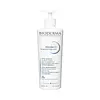What's inside
What's inside
 Key Ingredients
Key Ingredients

 Benefits
Benefits

 Concerns
Concerns

 Ingredients Side-by-side
Ingredients Side-by-side

Water
Skin ConditioningGlycerin
HumectantParaffinum Liquidum
EmollientHelianthus Annuus Seed Oil
EmollientBehenyl Alcohol
EmollientSucrose Stearate
EmollientCanola Oil
EmollientHydroxyethyl Acrylate/Sodium Acryloyldimethyl Taurate Copolymer
Emulsion StabilisingPentylene Glycol
Skin ConditioningBeta-Sitosterol
Emulsion StabilisingXylitol
HumectantZinc Gluconate
Skin ConditioningAcrylates/C10-30 Alkyl Acrylate Crosspolymer
Emulsion StabilisingPalmitamide Mea
1,2-Hexanediol
Skin ConditioningCaprylyl Glycol
EmollientSodium Citrate
BufferingMannitol
HumectantRhamnose
HumectantSodium Lauroyl Lactylate
EmulsifyingSodium Hydroxide
BufferingPolysorbate 60
EmulsifyingSorbitan Isostearate
EmulsifyingTocopherol
AntioxidantPhytosphingosine
Skin ConditioningCeramide NP
Skin ConditioningEthylhexylglycerin
Skin ConditioningCeramide AP
Skin ConditioningCholesterol
EmollientCarbomer
Emulsion StabilisingXanthan Gum
EmulsifyingFructooligosaccharides
HumectantCaprylic/Capric Triglyceride
MaskingLaminaria Ochroleuca Extract
Skin ConditioningCitric Acid
BufferingCeramide EOP
Skin ConditioningWater, Glycerin, Paraffinum Liquidum, Helianthus Annuus Seed Oil, Behenyl Alcohol, Sucrose Stearate, Canola Oil, Hydroxyethyl Acrylate/Sodium Acryloyldimethyl Taurate Copolymer, Pentylene Glycol, Beta-Sitosterol, Xylitol, Zinc Gluconate, Acrylates/C10-30 Alkyl Acrylate Crosspolymer, Palmitamide Mea, 1,2-Hexanediol, Caprylyl Glycol, Sodium Citrate, Mannitol, Rhamnose, Sodium Lauroyl Lactylate, Sodium Hydroxide, Polysorbate 60, Sorbitan Isostearate, Tocopherol, Phytosphingosine, Ceramide NP, Ethylhexylglycerin, Ceramide AP, Cholesterol, Carbomer, Xanthan Gum, Fructooligosaccharides, Caprylic/Capric Triglyceride, Laminaria Ochroleuca Extract, Citric Acid, Ceramide EOP
Water
Skin ConditioningDiglycerin
HumectantGlycerin
HumectantPolyglyceryl-10 Eicosanedioate/Tetradecanedioate
Skin ConditioningAcrylates/C10-30 Alkyl Acrylate Crosspolymer
Emulsion StabilisingCarrageenan
Caprylyl/Capryl Glucoside
CleansingEthylhexylglycerin
Skin ConditioningParfum
MaskingSodium Benzoate
MaskingMaris Aqua
HumectantSodium Phytate
Sodium Hydroxide
BufferingSodium Hyaluronate
HumectantPhenethyl Alcohol
MaskingLaminaria Digitata Extract
Skin ProtectingChlorella Vulgaris Extract
Skin ConditioningSaccharide Isomerate
HumectantWater, Diglycerin, Glycerin, Polyglyceryl-10 Eicosanedioate/Tetradecanedioate, Acrylates/C10-30 Alkyl Acrylate Crosspolymer, Carrageenan, Caprylyl/Capryl Glucoside, Ethylhexylglycerin, Parfum, Sodium Benzoate, Maris Aqua, Sodium Phytate, Sodium Hydroxide, Sodium Hyaluronate, Phenethyl Alcohol, Laminaria Digitata Extract, Chlorella Vulgaris Extract, Saccharide Isomerate
 Reviews
Reviews

Ingredients Explained
These ingredients are found in both products.
Ingredients higher up in an ingredient list are typically present in a larger amount.
Acrylates/C10-30 Alkyl Acrylate Crosspolymer is a synthetic polymer. It is used to thicken and improve the texture of products. Due to its properties, it can prevent water and oil ingredients from separating.
Ethylhexylglycerin (we can't pronounce this either) is commonly used as a preservative and skin softener. It is derived from glyceryl.
You might see Ethylhexylglycerin often paired with other preservatives such as phenoxyethanol. Ethylhexylglycerin has been found to increase the effectiveness of these other preservatives.
Glycerin is already naturally found in your skin. It helps moisturize and protect your skin.
A study from 2016 found glycerin to be more effective as a humectant than AHAs and hyaluronic acid.
As a humectant, it helps the skin stay hydrated by pulling moisture to your skin. The low molecular weight of glycerin allows it to pull moisture into the deeper layers of your skin.
Hydrated skin improves your skin barrier; Your skin barrier helps protect against irritants and bacteria.
Glycerin has also been found to have antimicrobial and antiviral properties. Due to these properties, glycerin is often used in wound and burn treatments.
In cosmetics, glycerin is usually derived from plants such as soybean or palm. However, it can also be sourced from animals, such as tallow or animal fat.
This ingredient is organic, colorless, odorless, and non-toxic.
Glycerin is the name for this ingredient in American English. British English uses Glycerol/Glycerine.
Learn more about GlycerinSodium Hydroxide is also known as lye or caustic soda. It is used to adjust the pH of products; many ingredients require a specific pH to be effective.
In small amounts, sodium hydroxide is considered safe to use. However, large amounts may cause chemical burns due to its high alkaline.
Your skin has a natural pH and acid mantle. This acid mantle helps prevent harmful bacteria from breaking through. The acid mantle also helps keep your skin hydrated.
"Alkaline" refers to a high pH level. A low pH level would be considered acidic.
Learn more about Sodium HydroxideWater. It's the most common cosmetic ingredient of all. You'll usually see it at the top of ingredient lists, meaning that it makes up the largest part of the product.
So why is it so popular? Water most often acts as a solvent - this means that it helps dissolve other ingredients into the formulation.
You'll also recognize water as that liquid we all need to stay alive. If you see this, drink a glass of water. Stay hydrated!
Learn more about Water